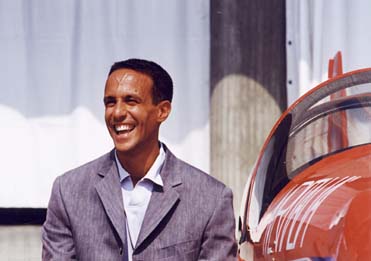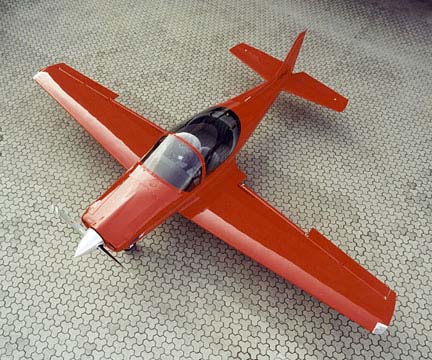
![]()
|
|
|
|
by Alfred Scott |
Famed Italian fashion designer Donatella Versace likes her airplanes big. Even for a local flight to Genoa, Venice or Florence, this busy businesswoman -- who took over Versace from her brother Gianni after his stunning murder in Miami several years ago -- will fly only in an opulent Gulfstream or Canadair Challenger. No ordinary business jet will do.
On the other hand, Donatella's marketing manager, Andrea Tremolada, prefers smaller aircraft. Learjets. Cessna Citations. Dassault Falcons. The lovely old Belgium Stampe biplane. And especially the aerobatic speed-machine designs of fellow Italian Stelio Frati -- the SIAI-Marchetti SF.260 and Frati's masterwork, the Falco.

Andrea Tremolada
Frati designed the sleek, all-wood Falco in 1955 as a wealthy sportsman's run-about, an aerobatic machine of perfection. A hundred aircraft were built by three Italian companies and the designs are prized for their looks, speed and handling. Even though the design is 45 years old, the design is breath-taking and modern. Stelio Frati got the shape and style of the sophisticated single-engine lightplane right nearly half a century ago.
But it's the handling of the Falco that pumps the adrenalin, creates the obsession, and spoils a pilot for a lifetime. Brazilian aviation writer Fernando Almeida once called it "The Best Airplane in the World," and a legion of monomaniacal kitplane builders would agree. Few aircraft inspire the passion and adoration that's accorded to the Falco, now assembled in garages and workshops of aviation's independent thinkers and do-it-yourselfers. Andrea Tremolada is one of them, and with the help of two assistants, he built the Falco in a Milan furniture factory.
In late July, the world's experimental-aircraft homebuilders will assemble at the Oshkosh airshow for the 45th birthday party of the Falco. Five years ago, a Brazilian builder/pilot, Marcelo Bellodi, flew his Falco across the Amazon, through the Carribean and then to Wisconsin just for the pleasure of attending a birthday party that didn't even have a cake.
And this year, to the horror of his boss Donatella Versace and the exasperation of designer Stelio Frati -- who has absolutely no desire to see one of his designs featured in an air-disaster headline -- Andrea Tremolada announced that he would fly behind his one small engine across the Atlantic to the Oshkosh birthday party. He installed tanks that hold 100 gallons of aviation gasoline in the tiny cockpit and mapped out a route across the South Atlantic to Brazil, with plans to return to Europe via Greenland and Iceland, across the frigid North Atlantic.

Most ferry pilots and lightplane adventurers intent on crossing the Atlantic choose the northern route rather than the seemingly shorter and easier jump from the tip of West Africa to Brazil. Why? Ask Andrea Tremolada, who just completed the Africa-to-Brazil leg and says it was the worst flight of his life.
First there was a problem with the fuel tanks in the cockpit. By necessity, the enormous tanks have large flat sides, and in the early flight tests, they failed and split open after only four hours of flight. Twice. Drenching the seats and filling the bottom four-inches of the airplane. With the water, fortunately, that Andrea carried on the test flights.
The problem was vibration. Steel-drum sympathetic music from the engine filled the cockpit with strange sounds that foretell the failure of a tank and fatigue aluminum weldjoints. And then the seam opens and the fuel dumps out. Were that to happen in flight over the Atlantic, in a cockpit filled with electrical circuits, the dangers would be terminal -- an in-flight fire or ditching in the water after fuel exhaustion. Once identified, the problem proved simple to fix. The tanks were covered with a stiffening sandwich of foam and fiberglass. And to the relief of all, they passed a short slosh-and-vibration torture test that proved that these tanks had lost their musical ear.
Thus it was with tone-deaf tanks and trepidation that Andrea set off, first on a flight from Bielli, Italy (just north of Milan) to Seville, Spain. The airplane flew slowly with full fuel on board, and the air traffic controllers in France were on strike, so Andrea flew over the sea for three hours, crossed the coast of Spain at Barcelona, and landed in Seville after 6 hours and 15 minutes.
Panic set in the next day when Andrea discovered a crack in the skin of the horizontal tail, but it was in a semi-structural area, and Andrea repaired it in a day. After all, if you can build a Falco in a Milan furniture factory, you can patch a skin in Seville.
Then it was off to Sal Island, Capo Verde, off the coast of Senegal in West Africa. With full fuel, the Falco was very difficult to fly for the first two hours, but flight conditions were good with no wind and a hazy sky. In all, it took 12 hours and 5 minutes, and Andrea landed tired and happy.
And on Monday, July 3, while America tanned at the beach and shopped for fireworks, Andrea Tremolada took off from Sal Island for the longest and most harrowing flight of his life. The first five hours were uneventful as he cruised between layers at 8,500 feet. He had a good tailwind, and even with the heavy load of fuel, he had a groundspeed of 160 to 170 knots.
The weather grew worse, and Andrea was soon flying in cloud and with no good information of what lay ahead. The trouble began about six hours from Brazil, when a sudden updraft threw Andrea from 8,500 feet to 15,000 and back to 12,000 in a couple of minutes, at times registering +6 and 4 g's, as he was slammed into his seat, and hung from his seatbelts.
For six hours he endured cockpit mayhem. Violent turbulence. Water and gasoline in the cockpit. Electrical system failure. Three hours without avionics. Blasting rain. And through it all, the 180-hp Lycoming chugged along as though it were a Sunday drive in the park.
He looked for clear air at 15,000 feet and found none. An Alitalia pilot at 35,000 feet reported that he was dodging the peaks of the towering thunderclouds and offered only sympathy. Andrea put it down on the deck and flew to Brazil at very low levels, sometimes down to 200 feet over the water, but still in such heavy cloud that he could not see the ocean below.
He planned a rest and fuel stop at San Fernando de Noronha, an island 300 miles from Recife, but the weather was so horrible that Andrea continued on for the Brazilian coast, where he landed in minimum instrument conditions.
After 13 hours, 43 minutes and 1,982 miles, an exhausted Andrea Tremolada rolled to a stop. The paint was blasted from the leading edge of the wing. The cockpit was drenched. The lettering and decals were stripped from the plane, and much of the electrical system was still inoperable. And after all this, it took three hours to deal with the officials at the airport. Andrea said he was too busy flying the airplane to be scared and he never lost control of the plane, but after landing, he didn't sleep at all that night.
From Brazil, Andrea will continue
on to the Carribean, Cuba and Oshkosh, and then re-cross the Atlantic
to return to his work amid the madness of Milan
traffic and the hysteria of the hyper-frenetic Italian fashion
industry. But it's a good bet that after this trip, demanding
supermodels, nervous designers and arrogant fashion-magazine editors
will never again seem quite the challenge they once were.
|
|
Go back to Andrea Tremolada